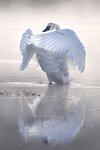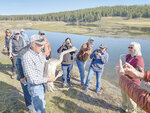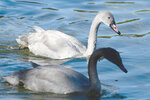Cloudy, 55° F
When Bill Long founded the Wyoming Wetlands Society in 1986, he did so as a precaution; “in case the trumpeter swan population in Yellowstone crashed,” he said.
Trumpeter swans in …
This item is available in full to subscribers.
The Powell Tribune has expanded its online content. To continue reading, you will need to either log in to your subscriber account, or purchase a subscription.
If you are a current print subscriber, you can set up a free web account by clicking here.
If you already have a web account, but need to reset it, you can do so by clicking here.
If you would like to purchase a subscription click here.
Please log in to continue |
|



When Bill Long founded the Wyoming Wetlands Society in 1986, he did so as a precaution; “in case the trumpeter swan population in Yellowstone crashed,” he said.
Trumpeter swans in Yellowstone National Park began declining in the early 1960s and by 2010 (24 years after Long started the nonprofit organization) only three birds were observed park-wide, according to park reports. Luckily, the society was already rearing semi-captive cygnets (baby swans) with Greater Yellowstone Ecosystem genetics, and, a year later and in conjunction with the park, the group provided the first cygnets for release along the Yellowstone River.
Now the group is celebrating 11 years of releases in the world’s first national park, totaling 64 of the beautiful waterfowl over the years.
“It’s a slow process, but we’re making progress,” Long said in a Tuesday interview.
The number of birds released each year varies; this year eight cygnets were released near the confluence of Alum Creek and the Yellowstone River at the north end of Hayden Valley. Today there are nearly 30 adult birds throughout the park with five pairs initiating nesting this year.
Members of the group have employed several methods over the years, from the releases of cygnets old enough to care for themselves to grafting younger individuals with adult swans already caring for a brood. The method is labor intensive, but results in a much higher survival rate; upwards of 90%-95%, Long said. The organization hopes to attempt to graft more cygnets starting next year.
The cause of decline
Trumpeters’ pristine white feathers and strong, black beaks stand out against the background of wetlands vegetation where they live. Because of their size, including 8-foot wingspans, they’re easy to identify. They’re also pretty loud in the habitat, as opposed to non-native mute swans which are as quiet as their name suggests. Identifying immature individuals is fairly easy, with their grayish head and neck and beaks glowing with a pinkish hue. Trumpeter cygnets do not get their iconic white plumage until the summer of their second year, according to the Trumpeter Swan Society.
“The cause for decline is unclear and is likely not attributed to one single cause,” said Linda Veress, spokesperson for the park. “Therefore, we have made efforts to bolster the population with the annual release of approximately 100 day old cygnets.”
Trumpeter swan cygnets can fly at about 110 days.
Long pointed to predation as one of the reasons for the recent decline. Wolves, coyotes, otters and eagles have all been documented preying on swans in the park. Fencing and electrical lines near wetlands in the birds’ flight path are also cause for concern.
“Swans are notorious for low flying when they take off from wetlands, especially in plains pothole scenarios. So it’s not just predation or potential starvation, but it’s also power lines and fence strikes,” Long said.
The birds, the largest native waterfowl species in North America, have trouble making sudden adjustments to their flight paths, making the manmade obstacles deadly foes. Winter can also be tough on captivity reared birds. They need to quickly learn how to mine tubers and eat roots and other aquatic plants before deciding to migrate or wintering in the area.
Their success in Yellowstone and several other habitats in the region is at least, in part, thanks to Long’s premonition decades prior to their first Yellowstone release. Along the way the organization has been helping to repopulate the species throughout the region, including habitat in Montana, Wyoming and Idaho. Volunteers for the organization monitor released birds weekly, Long said.
Adding beaver conservation to the project
In 2004, the organization also began working with beavers, yet another wetlands keystone species. Beavers trapped in this program are relocated to areas in the Gros Ventre River drainage to restore and enhance wetland habitat. Many of the beavers the organization live traps are clogging head gates, damaging expensive landscaping, or flooding yards and roads with their dam building activities on private property.
The organization built a special facility to hold beavers while they capture entire families. According to Wyoming Terrestrial Habitat Biologist Jerry Altermatt, if captured beavers are released one at a time, they will leave the translocation site to search for their colony — jeopardizing the project. The species are monogamous, mating for life for the most part.
In Wyoming, the lack of beavers (due to unregulated trapping) and their life-supporting dams causes incised vertical erosion, which disconnects the channel from the flood plain during high water periods.
“You want the water to come out of the banks, because that’s one of the ways that … floodplains get water,” Altermatt explained.
It also lowers the water table. The combination of the two geomorphic conditions removes floodplain vegetation with upland vegetation. Instead of having willows and sedges, you get sagebrush, dry-land upland species of grasses and possibly juniper, he said.
When you translocate beavers to incised riverine habitats, they build dams and, over time, wetlands can be restored, improving the habitat for many species.
Beaver dams not only created deep pools that supported large amounts of wildlife and plant-life, they trapped sediment. One study done on Currant Creek, in southwest Wyoming, showed suspended sediment loads dropped by 90% after the reintroduction of beavers. Another study in Washington showed that one dam can hold an average of 266 cubic-yards of sediment.
“Just to be able to visualize, 266 cubic-yards is 20 dump truck loads,” Altermatt said in a recent presentation at the Buffalo Bill Center of the West.
Swan surveillance
With the use of unique metal and black and yellow leg bands, the organization has confirmed that multiple trumpeter swan territories in Yellowstone are now occupied by birds released in previous years.
The organization relies largely on wildlife photographers who are able to capture images of the bands for reports on their movements. The beautiful birds are favorites for many local photographers, but few know of the program. Long hopes new reports will help the team follow their released birds, not only in the Yellowstone ecosystem, but along their migration routes as well.
The efforts thus far have proven to be successful with more birds and occupied breeding territories seen in decades, Long reports.
The Trumpeter Swan Fund was created by the organization in 1986 as a source of funding to support their trumpeter swan captive breeding program. They are currently producing about 40 cygnets per year.
“By 2025, our program will grow to 10 captive breeding pairs that may produce 60 cygnets or more per year,” Long said.
The Wyoming Game and Fish Department considers swans a species of special concern. Yet, like many other keystone species in varying habitats across the Yellowstone ecosystem and the state, attempts to save the species begins with conservation efforts to protect wetland habitats. That’s the rationale for also concentrating efforts on beaver conservation. The large rodents help build and expand wetlands while also benefiting swans directly. While on a mission to collect wild swan eggs in Canada, Long found that about 85% to 90% of all the nests they located were built on beaver lodges.
Over the three-year period of collecting eggs in Canada, the organization successfully hatched and raised nearly 150 cygnets from the project, resulting in improvements to the genetic diversity of our local Greater Yellowstone population and the captive breeding population, he said.
Long, a wildlife biologist, found a passion for saving wetlands due to his love for waterfowl hunting. Saving keystone species means saving wetlands, which, as a side benefit, brings in more ducks and geese. The Game and Fish funds the vast majority of their conservation work through hunting and fishing fees and federal taxes on their equipment. It’s a win/win for outdoor sportsmen and wildlife — especially species protected or of special concern in the state.
“Swans are iconic. People love them. And because of that, in a lot of cases, that means protecting wetlands,” Long said. “One of the reasons we started this program was to preempt a possible listing [for protections]. We have the program in place. We have the genetic makeup of birds suitable for release in national parks. When we first set up this flock, that was the intent.”
There’s a lot of satisfaction releasing their captively raised birds. Just seeing them living in the wild makes all the work worthwhile, Long said.
“Watching those birds in the wild; to me, that’s what it’s all about. Hopefully, when they come back, they’ll make babies and create their own legacy,” he said.
Wyoming Wetlands Society is a 501 (c)(3) nonprofit organization based in Jackson. Their mission is to protect and enhance wetlands and the associated flora and fauna for future generations. To do so, they rely on donations. For more information: wyomingwetlandssociety.org or call 307-203-2209.